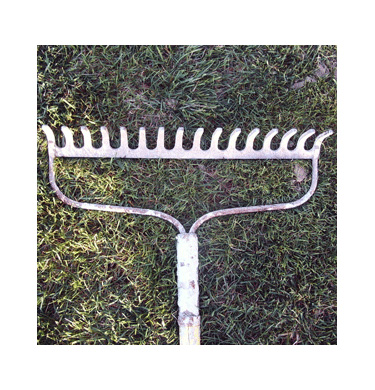


Regard the rake—not yet a relic, but a technology on the verge. In my imagined museum of ideal inventions, it is there beside the lever, pulley, hammer and wheel. What could be simpler, more primally expressive? The rake is a formal absolute. The handle and splayed tines are made to reproduce and extend the reach of arm, hand and fingers--the tine-ends even evoking, as we work, the gratifying scratch of fingernails across the scalp. To use a rake is to enter the season, which might explain why I, who am not by nature it a chore-loving person, have always made an exception for the chore that gets me out under the trees in late October to go at the vast accumulations of leaves in the yard. When I was growing up, in Michigan, my assigned duty had me bringing pile after pile from our yard down to the bottom of the driveway, where I would get to start and then maintain the leaf fire, the since verboten conflagration that was for me for years the very symbol of the season’s turn. Grown-up now and living in Massachusetts, I rake up barrels of leaves and build an enormous mound down in the far corner of our back yard.
Yes, I understand that I am reviewing a technology here, not indulging a private nostalgia fugue, but it’s also true that the meaning of any tool must be seen in its relation to its user, the feeling it evokes. Otherwise there is only the description of specifications and practical functions, and these, vital as they are, can be spelled out in a sentence of two. As in: a rake is a tool of extension with a long agricultural pedigree; it is an implement for gathering loose or strewn materials together for binding, baling or disposal. It is also a croupier’s reaching tool, and maybe other things as well, but these don’t concern me here.
I am really dealing here with the passing, the outmoding, of the rake, and for me to understand the tool is to grasp not just its function, but also its associations, all that is lost when one way of doing things is superceded by another. The handle and splayed tines are of course about work, enabling the reach-pull movements that bring the leaves all around me into workable piles, but they also connect me to a process saturated with personal meanings. Raking, you see, induces a very particular kind of thinking—rhythmic, repetitive, gratifyingly punctuated by intervals of rest—that is the source of a deep pleasure. A tool represents the kind of activity it enables, in this case a contemplation carried out in synch with specific movements, an immersion in the textures and smells of leaves and leaf-mulch. For me part of this contemplation involves a regular—and strangely invigorating—alternation of frames, with the zeroed-in immediacy of the eyes-to-the-ground exertion broken every few minutes by the sudden shift to the almost dizzying sense of panorama as I straighten up and look past my labors, out across the wooded area in back, where, now that the leaves have fallen, I can see the backs of the neighbors’ houses. Next I gaze up at the sky, and among the several lines of thought I unfailingly pursue is one that traces back to the activity itself, to rural cycles and ancient continuities.
I could, if I took license, talk about the sweet pall of leaf-smoke that used to hang in the air like soft cloth all along Tahquamenon Street back when I raked and tended the fires, and the thoughts and feelings I had then—which were, no surprise, those of a boy and then a teenager conjecturing his life, and I would have to say that they, too, belonged, if not to the rake, then the action of raking, the burning being the end of the gathering, and another way of filling the mind with the idea of cycles. But that would take me too far from the tool itself which I have begun to think of as yet another technology on the brink. The rake has not vanished, no, is not yet a relic--some can still to be found on display near the front door of our local hardware store every Fall--and I do still see a few people out in their yards in leaf-weather carrying out that familiar dip, pull, straighten-up movement--but the real action, at least here, on my street, in my neighborhood, has gone overwhelmingly to blowers. These devices are suddenly everywhere. I watch my neighbors with their small domestic blowers marching systematically from one side of the yard to the other, not a scrap of color in their wake, and more and more I also see the grand utility machines wielded by the crews of yard workers who arrive from who knows where with their high-paneled trucks and team-assault tactics. The technologies could not be different. The rake makes use of simple muscle strokes to pull and gather; the blower generates a power-stream of air to dispel. It is a continuation of wind by other means, breaking the link between sky and ground that the rake underscores, and completely eliminating the sound-palette available to the raker, which ranges from shush and crunch to the uncountable textures of crackling—never mind the smells, the gusts of dark soil and grass and rank leaf-mulch that are entirely blotted out by oil exhaust. The blower is a labor-saver, no question, but is this a labor we want to be saved from? I wonder. Though it is a chore, an exertion, raking is also a metaphysics, a bodily meditation full of enabling reach, a gradual, steady, purposeful gathering up of color.

